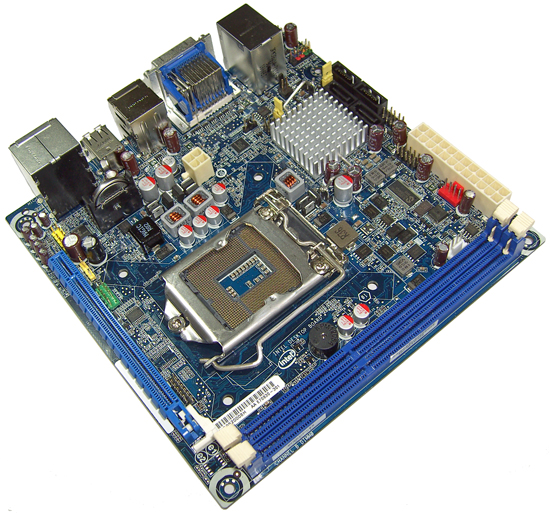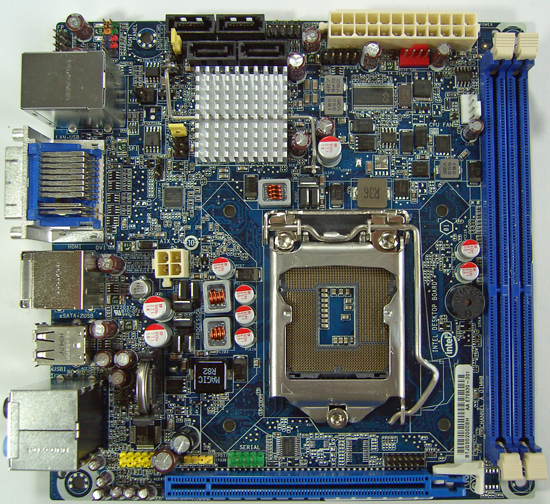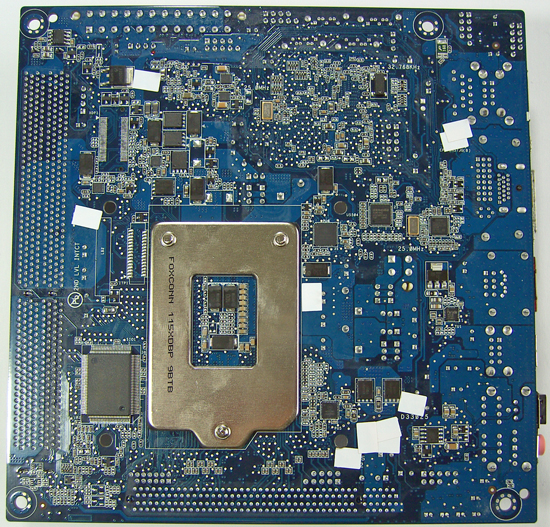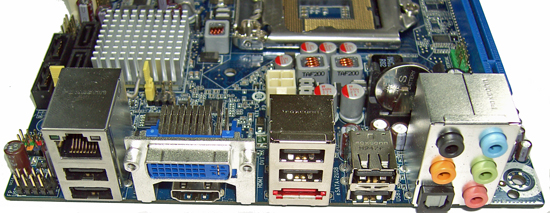Intel DH57JG “Jet Geyser” - Intel's First Mini-ITX H57
by Rajinder Gill on March 1, 2010 2:00 PM EST- Posted in
- Motherboards
Board Layout


Most of what you need is accessible, although you’ll need a case that has long leads for front panel switches as the front panel connector is placed in the top left corner of the board. BIOS jumper access gets a bit tricky once you plug in a few SATA cables and plug leads into surrounding connectors, the ideal place for the BIOS jumper would have been on the rear I/O panel.
Tall heatsinks are out because the CPU socket is placed very close to the DIMM slots and PCIe connector. That’s not a huge kicker though; CPU Vcore is supplied by a 3 phase circuit using small vertically mounted FETs, shattering any dreams of super-duper overclocks.

Moving over to the back, the CPU socket area is crowded with components. Intel definitely have stock heatsinks in mind as there’s no clearance for coolers that need backplates.

Zotac managed to cram 10 USB ports onto the rear I/O panel of their H55 board, Intel only supply six (the remaining six are available via onboard headers only). There are no PS/2 and VGA out ports either; space could certainly have been utilized better. As we mentioned above, the BIOS jumper should have been placed here for easy access.










34 Comments
View All Comments
hansblix - Monday, March 1, 2010 - link
Agreed. I think I'm on the Mini-ITX bandwagon now. A tiny, quiet, efficient yet reasonably powerful gaming system would be a fun project.MadMan007 - Monday, March 1, 2010 - link
I think it would be neat if Intel came out with an 'extreme' m-ITX motherboard although they might have to omit the glowing skull. More robust components and options for overclocking might make it a superior choice to other mITX motherboard for SFF enthusiasts. It's nice that Intel at least properly implements VRM cyrrent protection, it is rather sad that there were many insteances of blown VRMs on some P55 boards.MadMan007 - Monday, March 1, 2010 - link
You guys need to check that spec chart and take a look at the actual mobo. I only see 4 internal SATA and one eSATA, no coax S/PDIF on the I/O panel (a two-pin header is mentioned separately)Rajinder Gill - Monday, March 1, 2010 - link
Sorry, I've updated the table...JonnyDough - Monday, March 1, 2010 - link
Any nice ITX gaming build articles coming out any time Raj? I'd like to see what awesome/cheap kind of tiny LAN party box I can get with a nice single slot card to run modern FPS. Do it under $1K for sure if possible.i.e. (possibly?)
XFX single slot 5670
Any solid, non-OCable ITX board is fine as long as it is good value and has good location of PCI-E x16 slot etc. (USB 3.0 if/when possible and either Intel or AMD is fine)
4GB of ram (8GB if possible on two slots provided you find an excellent value ram set on the cheap)
Case, preferrably black with solid PSU (or even better if you can fit a full modular one in with proper capabilities)
Periphrals not required in the build, but it would be nice to see the OS added into the system, as Windows is required for LAN parties. Nobody hosts Linux gaming parties around here that I'm aware of.
Might also make mention of a solid gigabyte switch like the 8port Rosewill one listed on Newegg for $29 (currently), and the free games available like EA's recent free release of a good portion of the C&C franchise series.
Let's get gaming!
Rajinder Gill - Monday, March 1, 2010 - link
Hi JD,I'll pass on the request, I think we should have someone to cover cases and the like onboard soon.
regards
Raja
Murst - Monday, March 1, 2010 - link
I'm currently looking for a Micro ITX case to replace my Atom board in an Acer Easystore. I really like how the Easystore looks and how easy it is to add/remove drives, but the Atom isn't capable of handling software like PlayOn, and I want to use the EasyStore for streaming to my PS3.This board would be a pretty good fit (6 SATA is great- I only need 4, but a lot of mini ITX don't even have 4). However, what I don't want is a power hungy processor, and even the i3 is a 73W, which seems rather high.
Hopefully Intel will come out with some lower power 1156 processors. Either that, or a Mini ITX board comes out with support for the mobile i3/i5/i7 processors. Actually, I really don't understand why no one sells mini ITX w/ mobile processor sockets. That would be ideal for really small HTPC or Home Server setups.
strikeback03 - Tuesday, March 2, 2010 - link
There were mini-ITX boards for previous generation mobile processors (though they were expensive), I imagine there will be for current generation ones as well at some point.deruberhanyok - Monday, March 1, 2010 - link
Murst,You might want to check out SPCR's i5-661 article. Thought the i3 processors are given a 73W rating, actual power draw is much lower than that.
In their tests, playback of an h264 blu-ray disc showed power use of 43W DC. Full system with CPU and GPU at load didn't even hit 70W. And that's with the i5-661, which would draw more power than a regular i3 due to its increased CPU and GPU clock:
http://www.silentpcreview.com/article1013-page4.ht...">http://www.silentpcreview.com/article1013-page4.ht...
http://www.silentpcreview.com/article1013-page5.ht...">http://www.silentpcreview.com/article1013-page5.ht...
They are already lower power than advertised. I think the i3 series could have been listed as 60W or even lower and still have had plenty of headroom in the power rating.
This is, incidentally, one of the reasons I made the suggestion of testing in a more realistic system configuration than the test setup used here.
MadMan007 - Monday, March 1, 2010 - link
TDP doesn't mean power draw and was enver meant to imply power draw anyway so they aren't 'rated' to draw that much power in the first place. (Sorry, it's just one of my pet peeves when people equate TDP to power draw.)